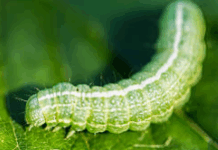K-State horticulture expert shares tips for the transition
MANHATTAN, Kan. – Although September has been unseasonably warm, Kansas State University horticulture expert Ward Upham advises moving houseplants indoors to protect them from dropping temperatures.
“Many people with houseplants move some of them outside for the summer to give them better growing conditions and help them recover from the stress of an indoor environment,” Upham said.
When night temperatures begin to consistently dip into the 40s, it is a sign to start transitioning houseplants to the indoors. The indoor conditions will ensure they survive the harsh weather of winter.
Before bringing plants into the house, Upham advises inspecting them for insects and disease. If you find evidence of insects on your plants, there are two methods of removal: spray or soak.
“A sharp spray from a garden hose can removed insects or mites from houseplant foliage,” he said. “Insects in the potting soil can be forced out by soaking the pot in a tub of lukewarm water for about 15 minutes.”
The biggest challenge for plants moving indoors is the adjustment to less sunlight. Start plants out in an area that receives the most light, then gradually start moving the plant to its more shaded, final location.
“This process should take 4-8 weeks depending on the degree of difference in light levels between the initial and final location of the plant,” Upham said.
Ensuring a houseplant’s gradual adjustment to the indoor temperatures and light increases their likelihood of retaining leaves and staying healthy – avoiding the stress of having to completely replace your favorite plant.
Upham and his colleagues in K-State’s Department of Horticulture and Natural Resources produce a weekly Horticulture Newsletter with tips for maintaining home landscapes. The newsletter is available to view online or can be delivered by email each week.
Interested persons can also send their garden- and yard-related questions to Upham at wupham@ksu.edu, or contact your local K-State Research and Extension office.
-30-
FOR PRINT PUBLICATIONS: Links used in this story
K-State Horticulture Newsletter, https://hnr.k-state.edu/extension/info-center/newsletters/index.html
K-State Research and Extension local offices, www.ksre.k-state.edu/about/stateandareamaps.html
K State Research and Extension is a short name for the Kansas State University Agricultural Experiment Station and Cooperative Extension Service, a program designed to generate and distribute useful knowledge for the well being of Kansans. Supported by county, state, federal and private funds, the program has county extension offices, experiment fields, area extension offices and regional research centers statewide. Its headquarters is on the K State campus in Manhattan. For more information, visit www.ksre.ksu.edu. K-State Research and Extension is an equal opportunity provider and employer.
Story by:
Taylor Jamison
tjamison@ksu.edu
For more information:
Ward Upham
785-532-6173
wupham@ksu.edu





